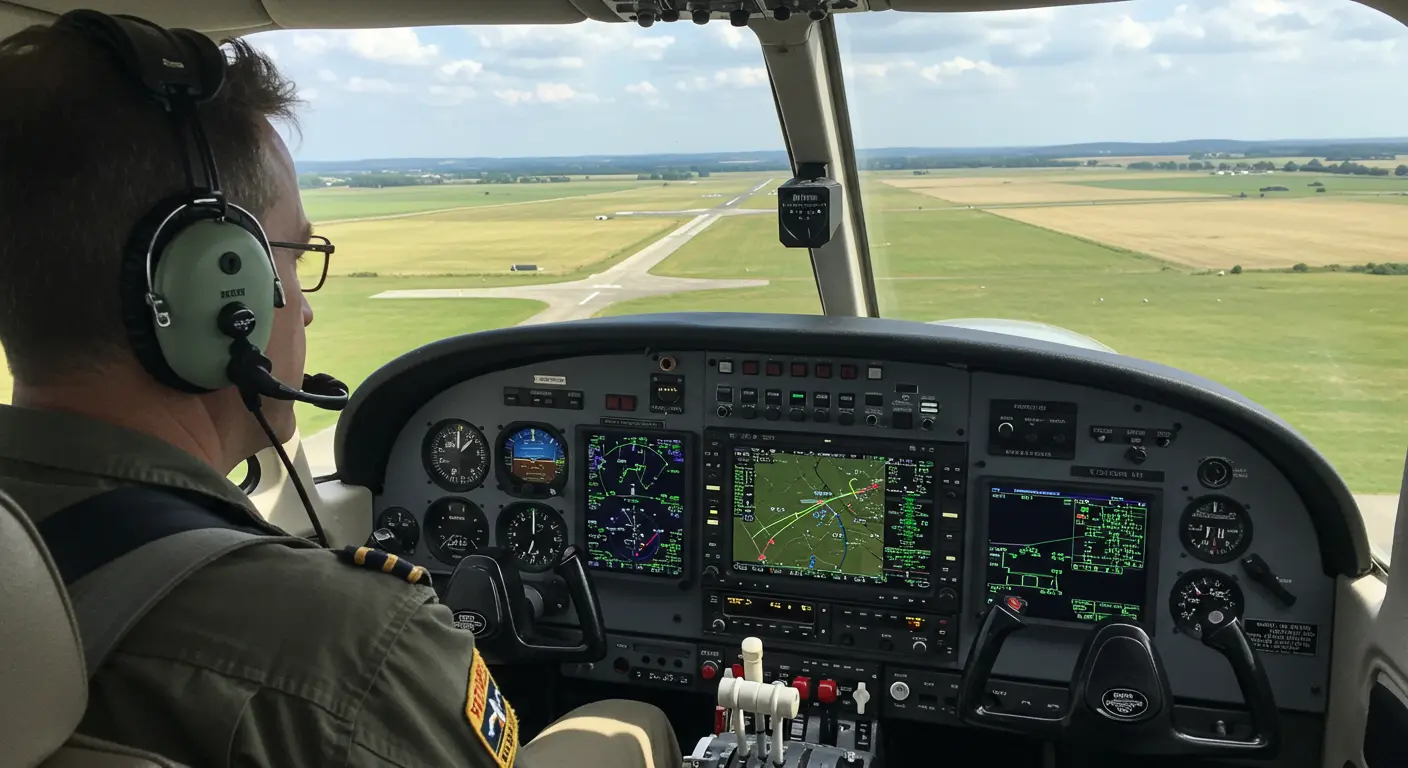Understanding Visual Descent Point (VDP)
A Visual Descent Point (VDP) acts as a key reference point in aviation navigation for non-precision instrument approaches. The Aeronautical Information Manual (AIM) defines it as: “a defined point on the final approach course of a non-precision straight-in approach procedure from which normal descent from the MDA to the runway touchdown point may be commenced.”
Simply put, the VDP marks that crucial moment during an approach when pilots can safely begin their descent below the Minimum Descent Altitude (MDA) toward the runway—but only if the runway environment is clearly visible. You’ll spot the VDP on approach charts as a bold ‘V’ symbol, strategically placed to guide pilots executing straight-in non-precision approaches.
Why does this matter? The VDP eliminates dangerous guesswork by providing a standardized, mathematically calculated point for initiating a stabilized visual descent to the runway, enhancing safety through proper descent angle management.
VDP and Minimum Descent Altitude (MDA)
Understanding the relationship between VDP and MDA is essential for understanding non-precision approaches. The MDA represents the lowest altitude a pilot may descend without establishing visual contact with the runway environment. The VDP, conversely, pinpoints the optimal moment to begin descending from this protective altitude floor.
Without a VDP, pilots face a difficult choice. They might maintain the MDA until dangerously close to the runway, then execute a steep, potentially catastrophic descent. Alternatively, they could begin descent prematurely, risking collision with obstacles. The VDP removes this uncertainty by providing a calculated point that balances the approach profile while preserving crucial safety margins.
Calculating the Visual Descent Point
Calculating the Visual Descent Point follows a straightforward formula. The standard calculation relies on a typical 3-degree approach angle—widely considered optimal for most aircraft types and approach scenarios.
The rule of thumb formula for determining the VDP is:
Visual Descent Point = Height Above Touchdown / 300 feet
Here’s how it works: the Height Above Touchdown represents the vertical distance between the Minimum Descent Altitude and the runway touchdown zone elevation. Divide this height by 300, and you’ll get the VDP’s distance in nautical miles from the runway threshold. This calculation establishes the standard 3-degree glide path—the preferred approach angle used in precision approaches.
Consider this example: if an aircraft flies at an MDA placing it 600 feet above the touchdown zone elevation, the VDP sits approximately 2 nautical miles from the runway threshold. Simple math: 600 ÷ 300 = 2.
Factors Influencing VDP Calculations
-
Aircraft and Speed: Heavier or faster aircraft demand more distance to descend and stabilize their approach. A nimble single-engine plane can handle a steeper descent than a massive commercial jet.
-
Environmental Conditions: Wind and visibility are important considerations. Crosswinds, tailwinds, or headwinds alter ground speed and affect descent timing, while poor visibility may prevent pilots from spotting required visual cues at the VDP.
-
Altitude and Pressure: At higher elevations, aircraft performance changes may necessitate adjustments to the standard 3-degree approach angle. Non-standard atmospheric pressure can also demand modifications.
-
Terrain and Obstacles: Surrounding terrain may require VDP adjustments to ensure adequate obstacle clearance during the visual descent phase.
VDP in Approach Procedures
The Visual Descent Point improves non-precision approach procedures by standardizing what was once a variable and potentially hazardous phase of flight. On approach charts, you’ll find the VDP specifically included for straight-in, non-precision approaches where a stabilized visual descent from the MDA to the runway touchdown point becomes feasible.
During approach execution with a published VDP, pilots carefully monitor their position along the final approach course until reaching this defined point. Upon arriving at the VDP with required visual references established, they can initiate a normal descent from the MDA toward the runway touchdown zone. This creates a more consistent, predictable approach profile that mirrors the stable descent path of a precision approach.
Here’s the catch: not all non-precision approaches feature a published VDP. When it’s absent from the approach chart, pilots must rely on their judgment and potentially perform their own calculations to determine an appropriate descent initiation point from the MDA. This highlights the significant value of a published VDP in standardizing approach procedures and enhancing safety.
Missed Approach Procedures Related to VDP
At the VDP, pilots confront a critical decision with three primary options:
-
Continue and Land: If the runway environment is clearly visible and a stable approach can be maintained.
-
Initiate a Missed Approach: If visual references prove insufficient or the approach becomes unstable.
-
Follow Other Instructions: In some cases, specific approach procedures may provide alternative directives.
Experienced pilots often treat the VDP as an absolute decision point. Can’t see the runway from the VDP? They execute a missed approach immediately rather than continuing toward the missed approach point. This disciplined practice prevents unstable approaches before they become dangerous.
For safe instrument flying, pilots must thoroughly understand both the conditions for descending at the VDP and the specific missed approach procedures for each approach. This knowledge is essential for sound decision-making, particularly when challenging weather conditions test pilot judgment.
Significance of VDP in Aviation Safety
The VDP marks an important safety improvement for non-precision approaches, which historically suffer higher accident rates than their precision counterparts. It standardizes the final approach phase by providing a defined point to begin a normal, stabilized descent—reducing risky subjective decision-making.
More importantly, the VDP helps prevent the perilous practice of “diving” for the runway. This dangerous maneuver occurs when pilots maintain the MDA until the last possible moment, then attempt a steep, unstabilized descent. This technique has contributed to numerous runway overruns, particularly involving larger, faster aircraft.
Most importantly, the VDP provides an identifiable reference that supports confident decision-making. Runway visible at the VDP? Proceed with a normal landing. Can’t see it? Execute a missed approach immediately. This clear trigger prevents continuation of unviable approaches.
By structuring the critical transition from instrument to visual flight, the VDP has become an essential IFR safety tool. It promotes better decisions, ensures more consistent procedures, and ultimately saves lives.

